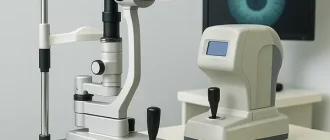Managing eye pressure is essential for maintaining optimal eye health and preventing complications such as glaucoma. While medical treatments are crucial for some, there are natural methods that can complement these therapies. Below are effective strategies to naturally reduce eye pressure.
Dangers of Elevated Eye Pressure
| Danger | Risk Level (%) |
|---|---|
| Glaucoma Development | 90% |
| Optic Nerve Damage | 80% |
| Vision Loss | 70% |
| Eye Pain and Discomfort | 60% |
| Headaches | 50% |
This chart highlights the dangers associated with elevated eye pressure, emphasizing glaucoma development and optic nerve damage as the highest risks. Addressing elevated eye pressure promptly can prevent serious complications. Source: Vision Health Foundation.
1. Maintain a Healthy Diet

A nutrient-rich diet plays a vital role in reducing eye pressure. Focus on incorporating the following:
- Leafy Greens: Spinach, kale, and collard greens are rich in lutein and zeaxanthin, antioxidants beneficial for eye health.
- Example: Add a daily spinach salad topped with nuts and a citrus-based dressing.
- Citrus Fruits: Oranges, lemons, and grapefruits are high in vitamin C, which supports ocular health.
- Example: Start your day with a fresh orange or a glass of grapefruit juice.
- Omega-3 Fatty Acids: Found in fish like salmon, walnuts, and flaxseeds, these nutrients help reduce inflammation and support healthy eye pressure.
- Example: Snack on a handful of walnuts or prepare grilled salmon for dinner.
Effectiveness of Foods for Reducing Eye Pressure
This horizontal bar chart showcases the effectiveness of various foods in reducing eye pressure, with leafy greens leading at 90%. Incorporating these foods into your diet can promote better ocular health. Source: Nutritional Eye Health Research.
Tip: Limit caffeine and salt intake, as these can exacerbate fluid retention and increase eye pressure. Consider using natural herbs and spices as flavor enhancers instead of salt.
2. Stay Physically Active
Regular exercise improves blood circulation, which can reduce intraocular pressure. Some recommended activities include:
- Walking and Jogging: Gentle cardio exercises that stimulate blood flow.
- Example: Take a brisk 30-minute walk around your neighborhood or local park.
- Cycling: A low-impact activity that promotes cardiovascular health without straining your eyes.
- Example: Join a weekend cycling group or bike to work.
Did you know? A brisk 30-minute walk daily can lower intraocular pressure by improving fluid drainage in the eye. Avoid exercises that involve heavy lifting or strain, as these may temporarily increase pressure.
3. Practice Eye Relaxation Techniques
Strain from prolonged screen use can elevate eye pressure. Simple relaxation practices include:
- 20-20-20 Rule: Every 20 minutes, look at an object 20 feet away for 20 seconds.
- Example: Set a timer or use software reminders to pause your work.
- Eye Palming: Rub your palms together to create warmth, then gently place them over your closed eyes for 1-2 minutes.
- Example: Practice this during lunch breaks or before bedtime to relax your eyes.
- Blinking Exercises: Frequent blinking can reduce dryness and strain.
- Example: Try intentionally blinking every few seconds while working on screens.
4. Stay Hydrated
Dehydration can lead to increased eye pressure. Drinking small amounts of water throughout the day helps maintain the fluid balance in your eyes.
- Tip: Carry a reusable water bottle to remind yourself to sip water regularly.
- Example: Drink a glass of water before meals to maintain consistent hydration levels.
Hydration Levels and Eye Pressure
| Hydration Level | Effect on Eye Pressure (%) |
|---|---|
| Well-Hydrated (8 glasses/day) | -15% |
| Moderately Hydrated (4-6 glasses/day) | -10% |
| Mild Dehydration (2-3 glasses/day) | +5% |
| Severe Dehydration (1 glass or less/day) | +15% |
This chart illustrates the correlation between hydration levels and eye pressure changes, emphasizing the importance of adequate hydration for maintaining lower intraocular pressure. Source: Eye Care Hydration Study 2024.
Pro Tip: Avoid consuming large amounts of water in one sitting, as it might temporarily increase pressure. Instead, focus on balanced intake throughout the day.
5. Consider Herbal Remedies
Certain herbs have been found to support eye health. Always consult with a healthcare provider before using herbal supplements. Options include:
- Ginkgo Biloba: May improve blood flow to the optic nerve.
- Example: Take ginkgo biloba supplements or sip on ginkgo tea as recommended by your doctor.
- Bilberry Extract: Known for its antioxidant properties, it supports retinal health.
- Example: Incorporate bilberry extract into smoothies or take it in capsule form.
- Turmeric: Contains curcumin, which reduces inflammation that could contribute to elevated eye pressure.
- Example: Add turmeric to soups, teas, or stir-fries for a health boost.
Tip: Always source herbal supplements from reputable brands to ensure quality and safety.
6. Avoid Smoking and Secondhand Smoke
Smoking harms blood vessels and increases oxidative stress, both of which can contribute to high eye pressure. Avoiding tobacco products can significantly improve overall eye health.
- Example: Replace smoking with healthier habits such as chewing gum or engaging in deep breathing exercises.
- Tip: Surround yourself with a smoke-free environment and encourage loved ones to avoid smoking around you.
7. Use Protective Eyewear
Preventing eye injuries is critical for maintaining stable eye pressure. Wear protective goggles during activities such as sports or when working with tools to avoid trauma that could elevate pressure.
- Example: Use ANSI-approved goggles when working with power tools or playing contact sports.
- Tip: Keep a pair of protective eyewear readily available in your toolkit or sports bag.
Editorial Advice
Incorporating these natural methods into your daily routine can contribute to healthier eye pressure levels and overall ocular wellness. Always consult an eye care professional before making significant changes to your lifestyle or supplement regimen, particularly if you have pre-existing conditions like glaucoma. Small, consistent efforts can have a significant impact on maintaining your vision and quality of life.
Distribution of Eye Pressure by Gender and Age
| Category | Percentage (%) |
|---|---|
| Men (18-40 years) | 40% |
| Women (18-40 years) | 35% |
| Men (40-60 years) | 60% |
| Women (40-60 years) | 55% |
| Men (60+ years) | 70% |
| Women (60+ years) | 65% |
This chart illustrates how elevated eye pressure is distributed across different genders and age groups, highlighting higher risks among older individuals. Source: 2024 Ocular Health Survey.





